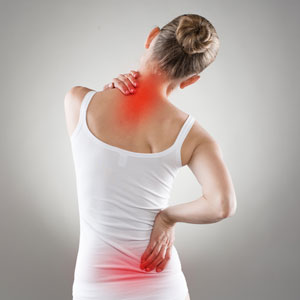 Spine, muscle, and nervous system conditions are the most common cause of long-term pain and physical disability. 1 Approximately 80% of adults will experience spine, muscle, and nervous system pain at some point in their lifetime.
Spine, muscle, and nervous system conditions are the most common cause of long-term pain and physical disability. 1 Approximately 80% of adults will experience spine, muscle, and nervous system pain at some point in their lifetime.
These types of pain are generally caused by repetitive strain, overuse, and physical activity-related injuries. 2 Low back pain is the most common example.
Common Symptoms of Spine, Muscle, or Nervous System Pain Include:
- Local or widespread pain that gets worse with movement
- Stiff and achy feeling throughout the body
- Fatigue
- Muscle twitching
- Burning/hot feeling
- Numbness/tingling
The symptoms of spine, muscle, and nervous system pain vary from individual to individual, however, there are certain symptoms associated with specific structures in the body 3:
- Muscle/Ligament Pain: This feels like dull and achy pain that is usually less severe than bone pain. If a muscle is torn or strained, a sharp, tearing or pulling sensation be felt during the range of motion of that muscle. Pain may or may not be present depending on the extent of the damage.
- Joint Pain: Joint pain is stiff and achy pain that is aggravated by moving the joint. It may or may not be accompanied by swelling/redness at the joint itself.
- Nerve Pain: With nerve pain, you would feel a burning, shooting, or numbness and tingling sensation. It may be accompanied by loss of strength or muscle bulk.
- Bone Pain: This would be deep, penetrating or dull pain. Bone pain can have many different causes (e.g., fracture). It can also be a sign of one of the most common forms of cancer (bone cancer). If you feel this type of pain, make sure see you get checked out by your doctor.
Spine, muscle, or nervous system pain is best treated by identifying and treating the cause. A chiropractor is trained in identifying and treating musculoskeletal pain. For more information visit your local chiropractor.
**Reposted from the Canadian Chiropractic Association**.
